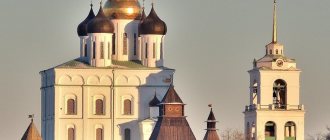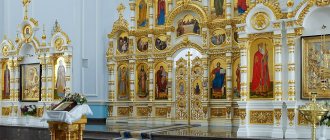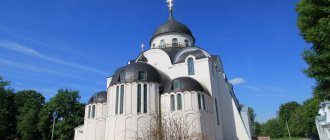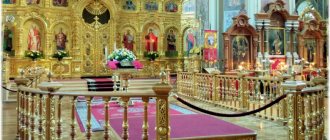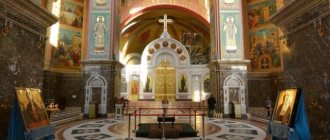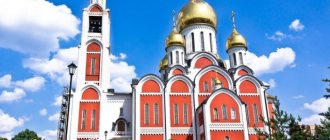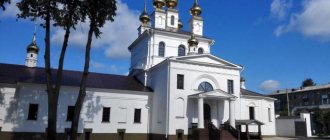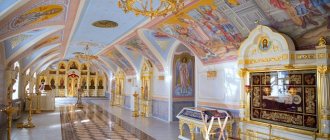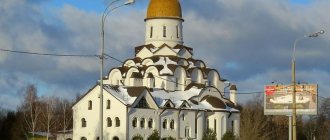Znamensky Cathedral is one of the most ancient Orthodox churches located in Tyumen. Its truly solemn and majestic appearance evokes genuine admiration from everyone who sees this unique structure for the first time.
Architecture of the cathedral, © Official VKontakte page
The cathedral attracts attention with its unusual architecture, internal volume, amazing tranquility, noble paintings of walls and vaults. The snow-white facade, set off by the azure blue of the roofs and numerous gilded domes topped with crosses, seems to float above the earth, emphasizing the mystical unity of the temple with heaven.
Hotels in Tyumen near the Znamensky Cathedral
Schedule of services in the Znamensky Cathedral
Services in the temple are held daily in the morning and evening.
- Liturgy on weekdays - at 08:30.
- Liturgies on Sunday - at 06:30 and 09:00.
- Evening service - at 17:00.
Requested prayer services are held Monday through Thursday at 2:00 p.m. The exception is holidays.
Znamensky Cathedral - schedule of services for March 2022
Patriarchal visit to the Cathedral of the Sign, © patriarchia.ru
History of the cathedral
Looking at the cathedral building, many will find it difficult to believe that it is almost 150 years old. But in reality this is true. Unfortunately, no one knows the exact date of construction of the church, but according to the data mentioned in history, it was around 1659.
The first temple stood for about 40 years. The first test was sent to him in the form of a fire. The temple burned down and in 1768 a plan for its reconstruction was specially developed and work began on the construction of a stone church. Along with the construction work, a garden was planted.
The best article for you, go to: Annunciation Cathedral, Voronezh
Later two more chapels were added. Three years later, construction work on the bell tower was completed. Today the Cathedral is a very beautiful building of complex shape. It hosts daily services.
It should also be noted that crusades in this temple have resumed since 1994. The largest Sunday school in Tyumen operates under him. Today there are more than 190 children aged 4 years and older studying there. The school provides lessons on studying the Law of God, church singing and the lives of saints. The educational institution also hosts various clubs on handicrafts, photography and much more.
History of the temple
There is no exact information about the founding date of the first wooden church. What is known is the period of its construction - between 1624 and 1659, and the fact that it had two aisles. One of the local legends says that the temple was built on the site of the appearance of the image of the Mother of God to a local coachman in memory of the heavenly sign. This is where the name Znamensky came from.
As a result of a severe fire in 1697, which turned the city into ashes, the wooden church also burned down. It was soon restored, but the fire of 1766 again destroyed the temple. In 1768, it was decided to lay the foundation for a new stone building. Initially, the building included a main room with a main altar, a vestibule with a two-tier bell tower, and a refectory with a warm aisle. In the latter, a throne was laid for the services held in winter. In front of the entrance there was a porch framed by round columns. The roof, dome, floor and fence enclosing the territory were made of wood.
Until 1837, the icon of the Last Judgment was located in the round window above the entrance. It was moved to the wall of the porch, and in its place an icon of the Mother of God “The Sign” was installed. In 1850, the process of reconstruction of the temple began. It was expanded, insulated, the old chapel was dismantled and a new one was built, which later burned down. The wooden flooring was dismantled and replaced with cast iron slabs. At the beginning of the 20th century, three chapels appeared, a new dome over the refectory, an additional tier in the bell tower structure and a richly decorated iconostasis. At the same time, landscaping of the surrounding area was carried out.
In 1913, the Znamenskaya parish church received the status of a cathedral. By 1917, the parish contained parochial schools, colleges and a girls' gymnasium.
The cathedral ceased functioning in 1929, but from 1933 to 1941 it was returned to believers. Then the temple was confiscated again, military units were placed in it, then a transit prison and even a machine and tractor station. After 1945, the Znamensky Church came under the jurisdiction of the Orthodox community. In the 90s of the last century, its new history of revival began.
Three-tier bell tower, © Official VKontakte page
Nowadays
The Znamensky Cathedral belongs to the Tobolsk Metropolis. The department of the metropolitan, who is also the rector of the church, is located here. The complex includes a Sunday school - one of the largest in the region. Parishioners and patrons of the arts are actively participating in the restoration of the Orthodox complex.
- In 1992, bells were delivered from the Far East.
- In 1994, religious processions were resumed.
- In 2002, the belfry was updated with 12 bells.
- In 2003, new domes and crosses were installed.
Currently, funds are being collected for the restoration of the interior of the cathedral.
Official website of the Znamensky Cathedral
Main entrance, © Official VKontakte page
Literature
- Tobolsk diocesan address-calendar for 1895, p. 166.
- Tobolsk diocesan address-calendar for 1897. Section three. Information about churches, clergy and parishes, p. 70-71.
- Church of the Sign of the Blessed Virgin Mary in the city of Tyumen
// Tobolsk Diocesan Gazette, 1898, No. 19, unofficial department, p. 458 - 467. - Journal of the Council of the Tobolsk Diocesan Orthodox Church Brotherhood.
September 6/16, 1899. No. 23 // Tobolsk Diocesan Gazette, 1899, No. 19, unofficial department, p. 269, 272, 275, 286. - Rebrin Peter, priest. Consecration of the Tyumen Church of the Sign
// “Tobolsk Diocesan Gazette”, 1901, No. 20, unofficial department, p. 476-480. - Tobolsk diocesan address-calendar for 1903. Information about churches and parishes, p. 10.
Icon of the Mother of God “The Sign”
The main shrine of the Znamensky Cathedral is revered as miraculous. It is believed that it was she who saved the Tyumen residents from the plague epidemic that occurred in 1848. The church chronicle mentions how one of the parishioners had a vision in a dream, which spoke of removing the icon from the bell tower, performing a prayer service and surrounding every house and the entire city with it.
The process was completed in ten August days, after which a real miracle happened. The epidemic retreated and disappeared into oblivion. This event is remembered and honored to this day. A year after the events described, the shrine was placed in a silver robe decorated with precious stones and given a place of honor in the temple.
The Icon of the Mother of God “The Sign” is a copy of the Novgorod miraculous icon, known since 1170 and located today in the St. Sophia Cathedral of Novgorod. It is assumed that the Tyumen prototype was made by local icon painter Spiridon at the beginning of the 17th century on canvas and pasted onto a cedar shield.
After the temple was closed in 1929, the shrine disappeared. According to one of the participants in the restoration work at the end of the 40s of the last century, the “Sign” icon was discovered with its face facing the wall on one of the tiers of the bell tower. Later it was either restored or replaced with a more modern list.
Architecture of the Znamensky Cathedral
The main temple of the city is located in the quiet historical center of Tyumen on Semakova Street, formerly called Podaruevskaya. The entire perimeter of the complex is surrounded by a stone fence with an elegant wrought-iron filling, allowing you to see the cathedral in all its glory without entering its territory.
The Znamensky Cathedral acquired its final architectural image as a result of several reconstructions carried out at the turn of the 19th and 20th centuries. Its construction lasted for one and a half centuries.
According to experts, the object is a striking example of the Russian or Siberian baroque style. The overall composition turned out to be so organic and picturesque that we can confidently speak about the significance of each of the facades of the temple. Despite numerous and lengthy reconstructions, the appearance of the cathedral has retained a single architectural style.
View of the Znamensky Cathedral from the street, © Official VKontakte page
One of the external features is the upward direction, unusual for Orthodox churches, vaguely reminiscent of the style of Gothic churches. A certain provincialism, emphasized by the originality and originality of Russian architecture, appears before the viewer in the form of:
- figured pediments;
- multi-tiered decorative domes;
- elongated windows;
- narrow corner pilasters;
- spatial game of volumes.
The dynamism of the architectural image is supported by snow-white facades, enriched with decorative elements of azure blue color, which do not allow the curved forms to visually merge with the walls.
The cozy area is decorated with flower beds and green spaces. There are benches for relaxation and a church shop where you can buy icons, crosses, candles and Orthodox books.
Znamensky Cathedral on Google panorama
History of the Tyumen shrine
Looking at the beautiful building, filled with majesty, it is difficult to imagine that it was built gradually over a century and a half. In the mid-seventeenth century, on the site of the modern magnificent temple stood a small wooden church built in honor of the icon of the Virgin Mary of the Sign. Historians have not come to a single date for its construction. In some documents it is 1624, in others it is 1659.
Znamensky Cathedral in Tyumen
The church was destroyed several times by fires in 1697 and 1766, but rose again. From 1766 to 1786, a stone temple grew on the site of the old wooden church.
The first temple complex included:
- main building;
- the porch of St. John Chrysostom and the bell tower;
- refectory.
Services were held in the main church in the summer. The warm church of St. John Chrysostom received parishioners when the cold weather set in. Over time, the temple complex fell into disrepair; in 1820, it was renovated, during which the wooden fence was replaced with a stone one, it was decorated with cast-iron gratings and two gates. The sagging old foundation was filled in with a new stone foundation in 1839.
Interior and interior decoration
The choirs of the cathedral with carved consoles and original wooden sheathing have been preserved from pre-revolutionary times. Round shapes and wide passages prevail in the temple. High arched openings lead into the spacious refectory, and from it into the southern and northern aisles.
The interior decoration is distinguished by a wealth of decorative elements, unique plot ornaments and paintings, presumably made on top of older images. The unique gilded iconostasis, like many other church property of the 18th-19th centuries, was lost. In the second half of the 1940s it was replaced by a new three-tier one. The main shrine of the cathedral is considered to be the icon of the Mother of God “The Sign”.
